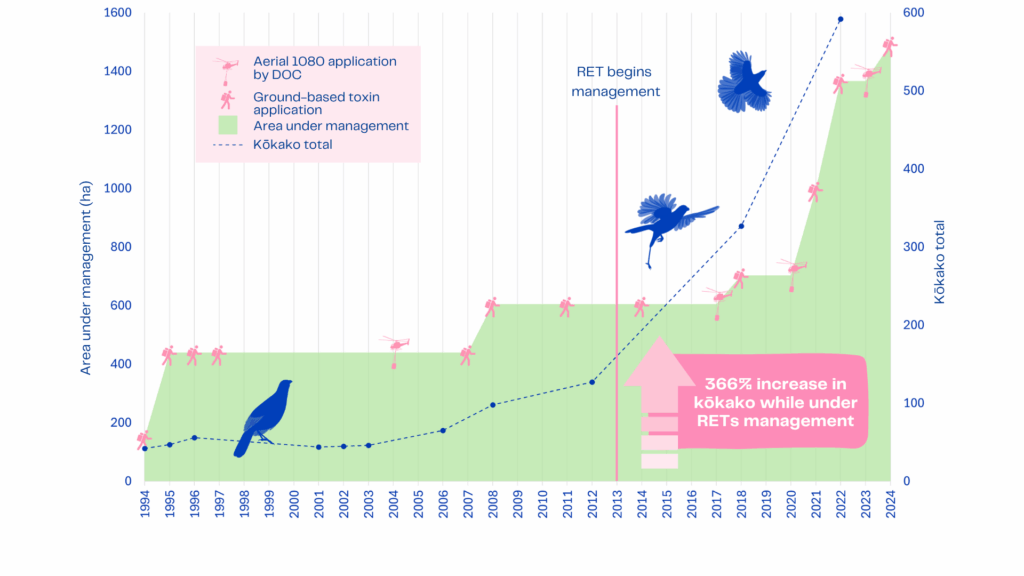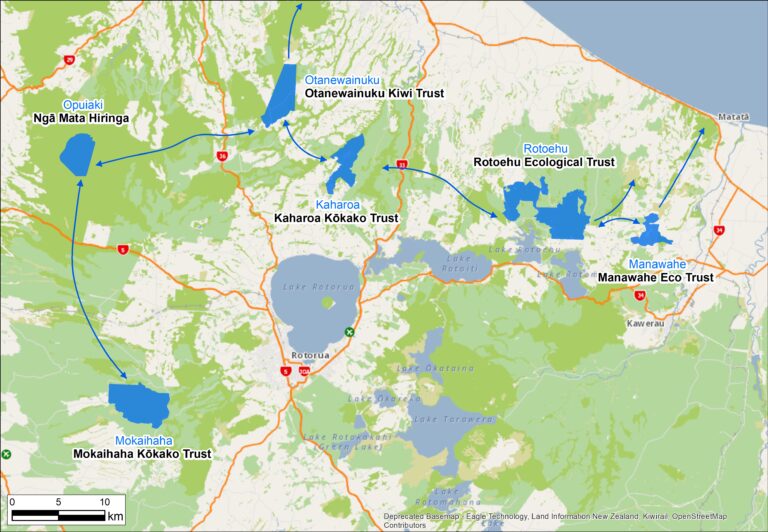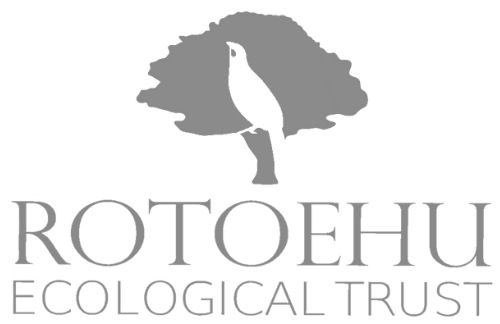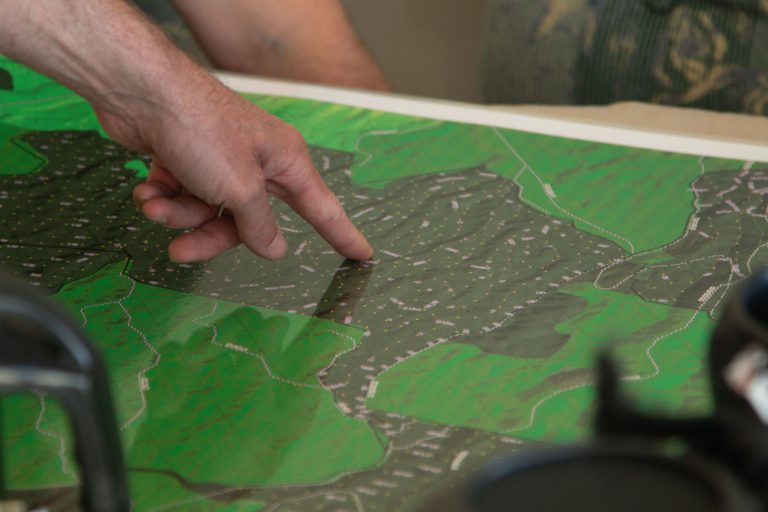Area under Management
Overview
The Rotoehu Ecological Trust currently oversees approximately 2000 hectares of native forest in Rotoehu Forest and Rotoehu Forest West, situated roughly 30 minutes northeast of Rotorua on Rotoehu Road. While Rotoehu Forest spans about 2,800 hectares, the Trust’s jurisdiction includes parcels within Rotoehu Forest (such as the Pongakawa Ecological Area, Otari Block, RF1, RF2, RF3 and RF4) as well as Rotoehu Forest West.
Within Rotoehu Forest lie significant cultural sites for Ngati Makino, Ngati Pikiao, Ngati Awa, and Tuwharetoa ki Bay of Plenty. Ngati Makino actively collaborate with the Department of Conservation (DOC) in efforts related to kokako recovery.
| Block | Area (ha) | Length of Track (km) | No. Bait Stations | No. Kokako 2019 | No. Kokako 2023 |
|---|---|---|---|---|---|
| PEA 1 | 437 | 61.0 | 578 | 143 | 224* |
| PEA 2 | 168 | 18.3 | 178 | 46 | 70 |
| PEA 2b | 261 | 30.1 | 265 | 46 | 85 |
| RFW | 36 | 4.1 | 39 | 7 | 12 |
| Otari | 94 | 7.2 | 129 | 18 | 24 |
| RF 1 | 51 | 5.5 | 57 | 4 | 11 |
| RF 2 | 320 | 33.9 | 319 | 22 | 45 |
| RF 3 | 125 | 13.4 | 125 | 16 | |
| RF 3b | 107 | 11.8 | 111 | 10 | |
| RF 3c | 270 | 9 | |||
| RF 4 | 180 | 8 | |||
| TOTAL | 2048 | 187.9 | 1801 | 286 | 514 |

Pongakawa Ecological Area
The Pongakawa Ecological Area (PEA) is a reserve of public conservation land managed by the Rotorua Department of Conservation Office. Originally subjected to native logging between the 1940s and 1970s, its preservation for conservation purposes owes much to the efforts of Te Puke Forest and Bird, particularly after the discovery of North Island Kokako inhabiting the area. PEA consists of three primary sections: the Main Block (439 ha), protected in 1990; Block 2a (168 ha), safeguarded in 2008; and Block 2b (261 ha), which was incorporated into our management area in 2020, initiating the first ground-based pest control operation in Spring 2021.
As part of the broader Rotoehu Forest, Pongakawa Ecological Area serves as a link to the Manawahe kokako population. However, the legacy of historic native logging has resulted in the absence of many larger trees from the canopy, while browsing by deer, wallabies, pigs, rabbits, and possums has led to a sparse understory. Surrounded by farmland and plantation forest, the entire area has been intermittently subjected to pest control efforts since its protection was established. Volunteers play a crucial role in maintaining the track network for ground control pest operations, aimed at safeguarding the approximately 380 kokako that call this patch of bush home.
Otari Block
In late 2015, the Otari Block joined the management area under the stewardship of the Trust. This inclusion followed a survey that confirmed the presence of kokako within the block. Situated adjacent to the primary region of the Pongakawa Ecological Area in the northeast, Otari is home to around 24 kokako. It stands as a largely pristine expanse of lowland forest, seemingly untouched by logging activities, and adorned with a thriving understory.
The Rotoehu Ecological Trust (RET) attributes the preservation of Otari to its terrain—a valley system with an additional lower ridge running through its center. In 2024, RET augmented this preservation effort by installing additional bait stations within the block, aimed at achieving closer proximity to the desired 100x100m spacing.
Rotoehu Forest West
The inclusion of this block in 2018 aimed to expand the Trust’s reach as far west as possible on Department of Conservation (DOC) land. Beyond this block lies plantation forest and a sizable area of native land under the Nga Whenua Rahui covenant.
Making a corridor to Manawahe
In 2022, Rotoehu Ecological Trust began work on establishing a broad forest corridor extending eastward from Rotoehu Forest to the Manawahe kōkako population. This corridor, formed by the RF1 to RF4 management blocks, connects the original PEA1 block and stretches south-east to Manawahe Road, where an unbroken expanse of native and pine forest already provides a natural link. The Manawahe population, managed by Manawahe Eco Trust, is smaller and has been bolstered in recent years through translocations from both Rotoehu and Kaharoa. While these efforts have supported kōkako numbers, creating a continuous corridor enables natural dispersal and breeding, offering a more sustainable approach to increasing population size and maintaining genetic diversity between forest strongholds.

Rotoehu Forest (RF) 1 and 2
These blocks were included in our management in 2022, with the inaugural ground control operation taking place that year. They play a vital role in our broader objective of supporting the Kokako Recovery Group’s target to establish populations consisting of 500 pairs of kokako and manage 2000 hectares of habitat as well as helping to create a protected corridor to Manawahe.
Rotoehu Forest (RF) 3
This block was incorporated into our management in 2024 and will be integrated into our ground-based pest control operation for the same year. These efforts are in line with our commitment to contributing to the Kokako Recovery Group’s objective of establishing populations comprising 500 pairs of kokako and managing 2000 hectares of habitat as well as helping to create a protected corridor to Manawahe.
Rotoehu Forest (RF) 3b
This block was incorporated into our management in 2025 and will be integrated into our ground-based pest control operation for the same year. These efforts are in line with our commitment to contributing to the Kokako Recovery Group’s objective of establishing populations comprising 500 pairs of kokako and managing 2000 hectares of habitat as well as helping to create a protected corridor to Manawahe.
Rotoehu Forest (RF) 3c and 4
These block are now being developed and will be ready for its first ground-based rat control operation in Spring 2027. It represents an exciting milestone for Rotoehu Ecological Trust and our volunteers — the final piece of our management area that brings us to the Kōkako Recovery Group’s goal of 2,000 hectares under protection.
By adding this block, we also complete the corridor of safe habitat through Department of Conservation land, creating the final link before reaching the privately owned land between the Manawahe and Rotoehu kōkako populations. This step has only been made possible through the dedication of our community and supporters, whose mahi continues to strengthen connections for kōkako and other native species.




